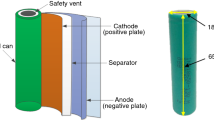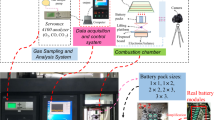Abstract
The use of lithium batteries requires understanding their fire and explosion hazards. In this paper, a report is given on an experimental study of the combustion characteristics of primary lithium batteries. Burning tests of single and bundles of primary lithium batteries were conducted in a calorimeter to measure their heat release rates when exposed to an irradiance of 20 kW m−2. Several variables including time to ignition, mass loss, heat release rate and plume temperature were measured to evaluate the ignition and combustion characteristics. The burning batteries were observed to have flame temperatures in excess of 1,200°C and to release corrosive compounds. The experimental results show that the combustion efficiency, carbon dioxide yield and mass loss are proportional to the number of batteries in the bundle. The total heat released by battery bundles was deduced empirically to be proportional to the number of batteries with a power of 1.26. The results provide experimental basis for the development of fire protection measures during the use, storage and distribution of primary lithium batteries.














Similar content being viewed by others
Abbreviations
- A :
-
Power factor
- m :
-
Molecularity of CO2
- n :
-
Number of batteries in a bundle
- \( \dot{Q} \) :
-
Heat release rate (kW)
- \( \dot{Q}_{n} \) :
-
Heat release rate of n number of batteries (kW)
- Q n :
-
Energy released from n number of batteries (kJ)
- \( \dot{Q}_{pk} \) :
-
Peak heat release rate (kW)
- RH :
-
Relative humidity (%)
- SOC:
-
State of charge (%)
- T :
-
Temperature (°C)
- T ∞ :
-
Ambient temperature (°C)
- t :
-
Time (s)
- t ig :
-
Time to ignition (s)
- t ex :
-
Time to extinction (s)
- W :
-
Fuel mass (g)
- W a :
-
Ash mass (g)
- W t :
-
Initial fuel mass (g)
- W * :
-
Dimensionless mass loss
- ΔH e :
-
Effective heat of combustion (kJ g−1)
- ΔW :
-
Mass loss (g)
- \( \varphi_{{{\text{CO}}_{ 2} /{\text{CO}}}} \) :
-
Ratio of mole fractions or volumetric concentrations of CO2 to CO
- σ pk :
-
Standard deviation of peak \( \dot{Q}_{pk} \) (kW)
- σ Q :
-
Standard deviation of energy released (kJ)
- Subscripts:
-
max maximum or peak value
References
Wang Q, Ping P, Zhao X (2012) Thermal runaway caused fire and explosion of lithium ion battery. J Power Sources 208:210–224
Farrington MD (2001) Safety of lithium batteries in transportation. J Power Sources 96(1):260–265
Lisbona D, Snee T (2011) A review of hazards associated with primary lithium and lithium-ion batteries. Process Saf Environ 89:434–442
Selman JR, Al Hallaj S (2001) Cooperative research on safety fundamentals of lithium batteries. J Power Sources 97–98:726–732.
Fan J (2004) Studies of 18650 cylindrical cells made with doped LiNiO2 positive electrodes for military applications. J Power Sources 138:288–293.
Underwriters Laboratories Inc (2005) UL Safety Issues for Lithium-Ion Batteries. Underwriters Laboratories, Northbrook
Shin-ichi Tobishima, Jun-ichi Yamaki (1999) A consideration of lithium cell safety. J Power Sources 81–82:882–886
Wang Q, Sun J, Yao X, Chen C (2006) Micro calorimeter study on the thermal stability of lithium-ion battery electrolytes. J Loss Prevent Proc 19:561–569
Mandal B et al (2006) Thermal runaway inhibitors for lithium battery electrolytes. J Power Sources 161:1341–1345
Roth EP, Doughty DH (2004) Thermal abuse performance of high-power 18650 Li-ion cells. J Power Sources 128:308–318
International Air Transport Association (2013) Lithium Battery Guidance Document, Revised for the 2014 Regulations
Webster H (2004) Flammability Assessment of Bulk-Packed, Report No. DOT/FAA/AR-04/26, Federal Aviation Administration, US Department of Transportation
Yao W, Hu X, Rong J, Wang J, Zhang H (2013) Experimental study of large-scale fire behavior under low pressure at high altitude. J Fire Sci 31(6):481–494
Ko YJ, Michels R, Hadjisophocleous GV (2011) Instrumentation design for HRR measurements in a large-scale fire facility. Fire Technol 47(4):1047–1061. doi:10.1007/s10694-009-0115-7
Overholt KJ, Ezekoye OA (2012) Characterizing heat release rates using an inverse fire modeling technique. Fire Technol 48(4):893–909. doi:10.1007/s10694-011-0250-9
Perrine R, et al (2012) Investigation on the fire-induced hazards of Li-ion battery cells by fire calorimetry. Energy Environ Sci 5(1):5271–5280
Niu Y, He Y, Hu X, Zhou D, Lin C, Yin J, Yao W, Wang J (2013) Experimental study of burning rates of cardboard box fires near sea level and at high altitude. Proc Combust Inst 34(2):2565–2573
Ditch B, Vries J (2013) Flammability characterization of lithium-ion batteries in bulk storage. FM Global, Norwood
ISO 9705-2003 Fire tests—Full-scale room test for surface products.
ISO 5660:1-2002 Reaction-to-fire tests—Heat release, smoke production and mass loss rate—Part 1: Heat release rate (cone calorimeter method)
Huggett C (1980) Estimation of rate of heat release by means of oxygen consumption measurements. Fire Mater 4(2):61–65
Janssens ML (1991) Measuring rate of heat release by oxygen consumption. Fire Technol 27(3):234–249. doi:10.1007/BF01038449
Rhein RA (1992) An experimental study of the use of liquid argon and argon-filled aqueous foams for the extinction of lithium fires. Fire Technol 28(4):290–316. doi:10.1007/BF01873399
Rhein RA, Carlton CM (1993) Extinction of lithium fires: thermodynamic computations and experimental data from literature. Fire Technol 29(2):100–130. doi:10.1007/BF01038535
Rodgers SJ, Everson WA (1965) Extinguishment of alkali metal fires. Fire Technol 1(2):103–111. doi:10.1007/BF02588480
Heskestad G (2008) Fire plumes, flame height and air entrainment. In: Dinenno PJ (ed) SFPE handbook of fire protection engineering. 4th edn. Society of Fire Protection Engineers, Boston
Glassman I (2008) Combustion. Academic Press, Amsterdam, Boston
Yang M, He Y, Li H, Zhang Z, Li Z, Wang J (2012) Combustion of laminar non-premixed acetylene jet at two different altitudes. Combust Sci Technol 184(12):1950–1969
Acknowledgments
This research was supported by the National Natural Science Foundation of China (No. 51376172).
Author information
Authors and Affiliations
Corresponding author
Rights and permissions
About this article
Cite this article
Chen, M., He, Y., De Zhou, C. et al. Experimental Study on the Combustion Characteristics of Primary Lithium Batteries Fire. Fire Technol 52, 365–385 (2016). https://doi.org/10.1007/s10694-014-0450-1
Received:
Accepted:
Published:
Issue Date:
DOI: https://doi.org/10.1007/s10694-014-0450-1




